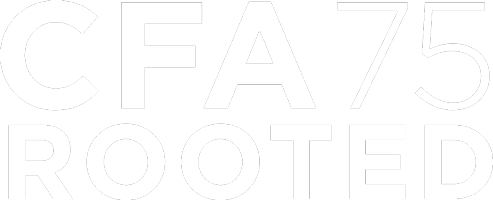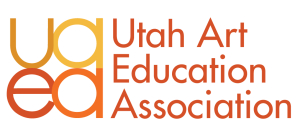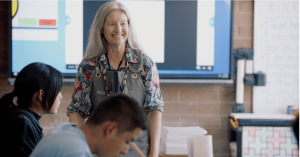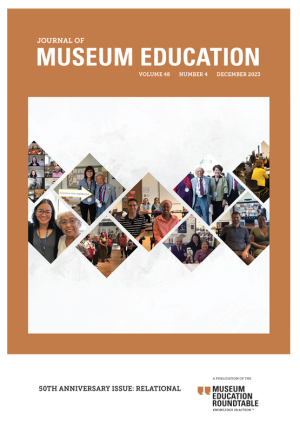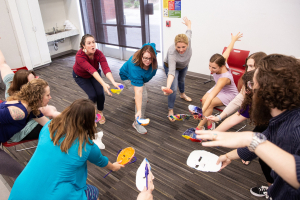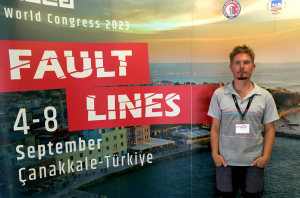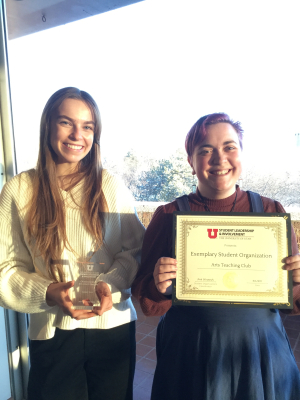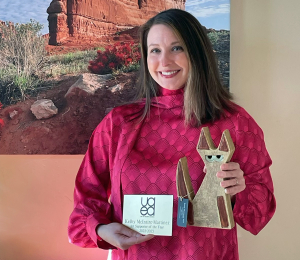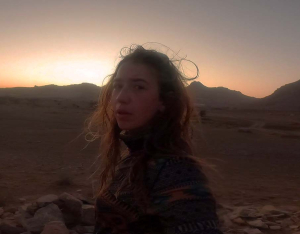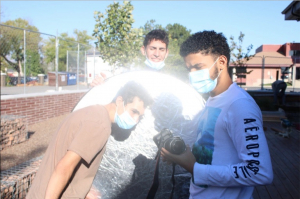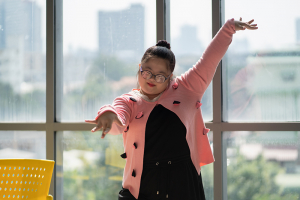Displaying items by tag: Arts Education
The Department of Art & Art History was prominently featured at the Utah Art Education Association’s 2023-24 state-wide awards ceremony. Congratulations to the department chairperson, Prof. V. Kim Martinez, and art teaching student Carlos Miranda-Rodriguez.
Professor V. Kim Martinez received the Utah Distinguished Service Outside the Profession Award. This award is open to any person or organization demonstrating significant support of visual arts education.
"I love art education because it allows me to aid students in expressing themselves creatively and explore multiple forms of artistic expression. As an art professor, sharing my artistic research experiences and processes with students can effectively inspire and motivate them. My goals are to support young artists in developing their unique artistic voices by giving them insight through their creative journey to develop critical thinking skills and invite them to analyze and interpret visual information."
—V. Kim Martinez
UAEA 2023-24 | Utah Distinguished Service Outside of the Profession Award to Prof. V. Kim Martinez from U of U College of Fine Arts on Vimeo.
Art Teaching student Carlos Miranda-Rodriguez received the Utah Preservice Art Educator Award.
"I was born and raised in Kearns / West Valley area and pretty much have lived there my whole life. I began my artistic journey in high school at Hunter High. My educator at the time, Rock Frampton really pushed me to stay engaged in his class. 8 years later with the support of mentors, family, and friends, I am a few weeks from graduating and becoming a full-time art educator myself!"
—Carlos Miranda-Rodriguez
UAEA 2023-24 | Utah Preservice Art Educator Award to Carlos Miranda-Rodriguez from U of U College of Fine Arts on Vimeo.
To learn more about UAEA, please visit their website: https://www.utaharteducation.org/.
MAT-FA alum Georgiana Simpson featured by Utah Business
Excerpted from original story by Judd Bagley for Utah Business
How Whitehorse High School visual arts educator Georgiana Simpson is bridging the equity gap in arts education
Most friendships are the result of happy accidents. The bond that connects Georgiana Simpson and Anna Davis, on the other hand, was premeditated. The bond was forged in an Indianola, Utah, cabin during the annual retreat for Utah Art Educators Association (UAEA) board members, Davis recalls.
“I’d briefly met Georgiana once before and immediately knew she was someone I needed to get to know better. I also knew there were more people than rooms in that cabin, so some of us would need to find roommates. I walked right up and told her she was going to be mine,” Davis remembers, laughing. “We started talking and couldn’t stop.”
The pair had much to share because their stories were so vastly different. Their births are separated by more than two decades. Simpson has long hair she’s allowed to go gracefully gray, while Davis has short hair dyed fiery red. For Davis, the route to a career in arts education was as deliberate and directed as a career path can be, while Simpson practically stumbled into hers at an age when most begin thinking about retirement.
As significant as those differences are, their professional experiences contrast even more.
Davis teaches art at Orem’s Timpanogos High School, in the middle of Utah’s largest school district with a student body that is, according to data compiled by U.S. News & World Report, almost 70 percent white and less than one percent Native American. Nineteen percent of students there qualify for free lunch.
Simpson teaches art at Whitehorse High School in Montezuma Creek, a town of about 300. Whitehorse sits within the borders of the Navajo Nation in one of Utah’s smallest school districts, with a student population that is 98 percent Native American and less than one percent white. Nearly 100 percent of students there qualify for free lunch, and only 30 percent have home internet access, according to Whitehorse Principal Kim Schaefer.
Read the profile on UtahBusiness.com
Joshua Graham (Department of Art & Art History) published in peer-reviewed Journal of Music Education
A manuscript titled Artists at the Museum, by assistant professor Joshua Graham of the Department of Art History, has been published in Vol. 48 of the peer-reviewed Journal of Museum Education, available through Taylor and Francis and online.
“Artistic and educational possibilities abound when institutions open their doors to local artists and allow them to work within their confines. The following case study articulates how the often unrecorded and unseen discourse between cultural workers leads to a deeper understanding and application of strategies that encourage effective collaboration. Made possible through my year-long appointment as an artist-in-residence at a contemporary art museum in Salt Lake City, UT, each example demonstrates how the relational exchange of knowledge between museum practitioners, artists, and the public results in new possibilities for community-engaged art education."
Is the UOnline Master of Arts Teaching—Fine Arts Program for you?
By Pam Davis, reposted from UOnline
Are you looking for a master’s program that would allow you to not only keep working, but gives you immediate tools you can utilize in your classroom? What would a magical program like that look like?
Let me introduce you to that exact program: UOnline’s Master of Arts in Teaching—Fine Arts (MAT-FA). Do you want to know if this program is right for you?
Read on to get the inside scoop and see!
“I would say, well, to do it... it's already helped me reinvigorate my own outlook, my own motivation.”
- Nick, MAT-FA student
What is the Master of Arts Teaching- Fine Arts?
The MAT-FA is a two-year, 30-credit, primarily online program, with a short on-campus residency each summer. It is an interdisciplinary degree that prepares and trains educators to work authentically alongside children, youth, and adults in a variety of educational, community, and artistic contexts. It emphasizes research and methods-based arts teaching techniques across the fine arts.
This unique program brings all the art forms together. Students within the program, as well as the faculty, have a variety of artistic backgrounds across the fine arts. This includes music, theater, dance (movement), visual arts, and film and media. Students can learn both from each other and from the expert faculty working in the same medium. This broad spectrum of expertise is used to build the curriculum, implement it, and support students as they complete the program.
The curriculum of the MAT-FA was meant to be utilized immediately and in real-time by students as they work on both their degree and their real-life jobs. With this goal in mind, it’s been refined and polished down to the essentials without fluff or filler so that students can get the highest quality information and have the best experience in the most efficient time possible.
A lot of online programs were created with the in-person experience in mind and then, when the pandemic hit, there was a scramble to create an online version. That isn’t the case with the MAT-FA program. It was envisioned as a hybrid online course from the beginning and created to take advantage of that platform while still creating a community among the students enrolled. This hybrid format allows students all over the country to enroll and fit it in around their current jobs.
Who is MAT-FA meant for?
The short answer: anyone with a background in the arts who has a passion for students, teaching, and the arts!
The longer answer is, well a little longer. You’ll need at least one of the following:
- A bachelor’s degree in a specific art form.
- A state arts endorsement in theatre, dance, visual arts, film, or music.
- A cognate education degree suitable to the study of arts teaching; or
- Commensurate arts teaching experience (meaning you’ve taught in the field and gotten real-world experience!)
If you have one of the above, the next thing you need is a commitment to the demands required of a graduate program. One of the benefits of the MAT-FA is that you can utilize everything you’re learning in your classroom immediately. You don’t need to be a licensed teacher or even a full-time educator to be accepted to the program.
It helps if you want to find a community of like-minded people; the friends, mentors, and colleagues you’ll come across in the MAT-FA program will support you while you’re taking the classes and long after. Speaking of mentors, do you want to learn from the best of the best in fine arts that the University of Utah has to offer? This program has tenured faculty that are still active in their field and from a variety of backgrounds.
This program is meant for you if you’re ready to dig a little bit deeper and build yourself. Who are you as an educator and a creator? You’ll find that out as you actively participate in the curriculum and implement it. This isn’t sitting behind a desk and watching, this is getting your hands dirty and learning.
So, is the MAT-FA meant for you? If you’re a seasoned artist and teacher and you’re ready for a new adventure of self-discovery to expand your skills, then the answer is a resounding YES!
What does the application process look like?
Ready to apply? Applications for UOnline’s MAT-FA program are accepted between August and March (for exact dates please visit the UOnline Master of Teaching—Fine Arts webpage) with an application fee of $55. To apply you need to go to this webpage to fill out the information and send your application materials.
The application materials required for UOnline’s MAT-FA program are:
- Statement of Purpose: a written statement where you describe your background, interests, and goals in the study of arts education. This is where you let the program know why you want to be there and why you belong.
- Resume or Curriculum Vitae: listing your educational background and experience within the arts.
- Letter(s) of Recommendation: one letter of recommendation is required, with a second one being optional. This letter will be requested by the MAT-FA program after you supply their information and they’ll submit the letter directly to the program.
- Arts Teaching Portfolio: this includes three lesson plans, a 5- to 8-minute video of you teaching within your medium, images of youth work and/or performances conducted alongside various community members, and (optionally) any other creative work that you want to include that relates to your teaching in the arts.
- Current Background Check: students must submit documentation of a cleared background check prior to recommendation for admission into the program.
After submitting everything via the application website above, top applicants will be interviewed by the Arts Education Committee.
Putting everything together for this application can feel a little daunting. But if you infuse it with your passion for your art, the passion for teaching, and show that you know what you’re doing, you’re sure to create something spectacular.
What are you waiting for?
If you’re looking for a way to move up in your career, become a better teacher, and find a community of fellow artists then UOnline’s Master of Arts in Teaching—Fine Arts could be exactly what you need! Check out the website and start working on your application today.
Questions? Reach out to the UOnline team at .
Assistant Professor Joshua Graham at The International Society for Education through Art World Congress 2023
Joshua Graham, assistant professor in the University of Utah Department of Art & Art History, recently traveled to Turkey to present at The International Society for Education through Art World Congress 2023.
The presentation followed a recent publication of Graham’s article “Strange Pedagogy: An artist-led educational model,” in inSEA’s official journal, the International Journal of Education Through Art. The cover image of this issue featured Graham working with students at the Great Salt Lake. 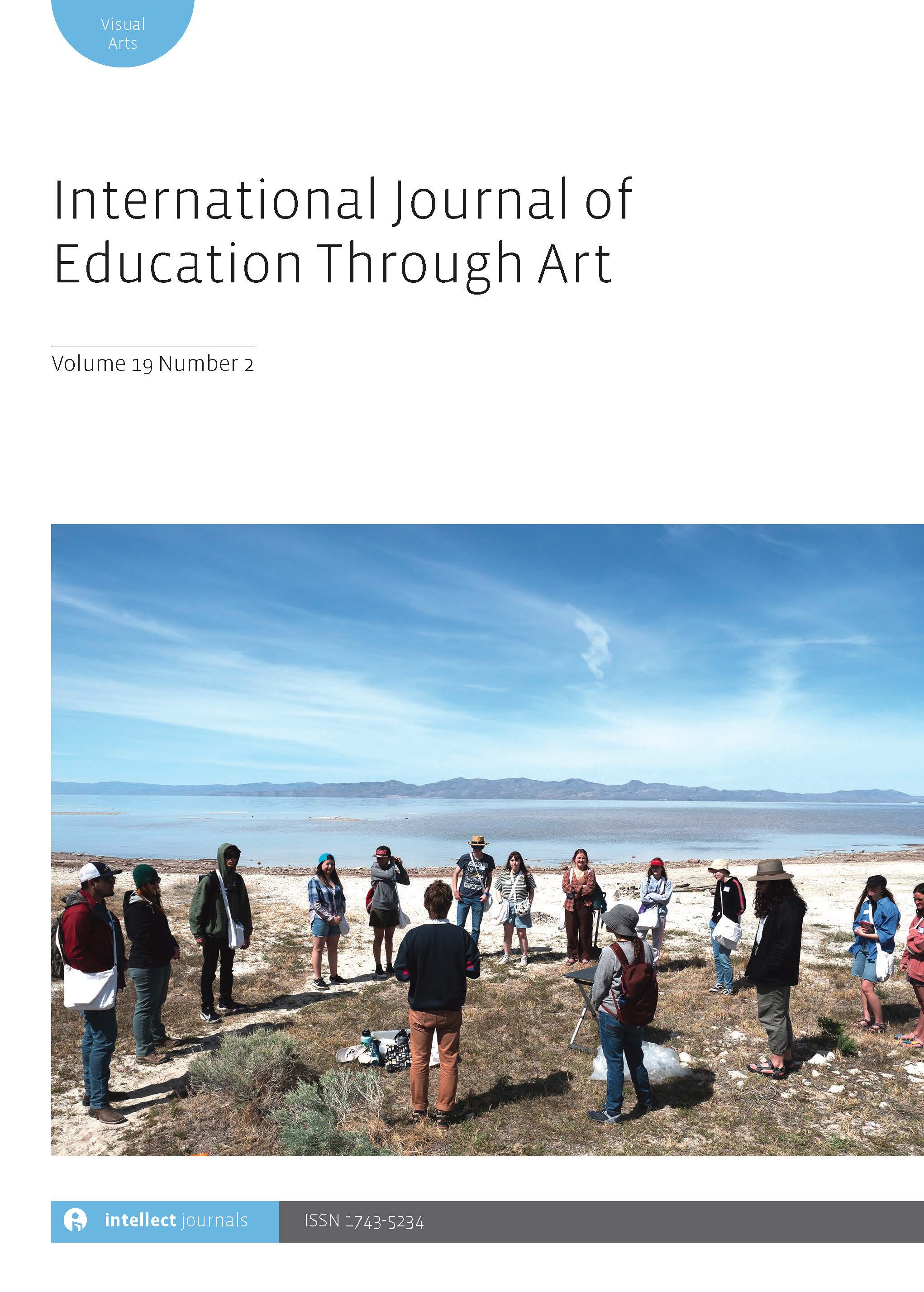
Participating in this conference gave me a platform to present my work on community-engaged education methodologies that foreground a place-based approach to art teaching to an international audience
“The International Society for Education Through Art (inSEA) World Congress is one of the world’s largest art education conferences and is held every two years at various locations around the world,” Graham said.
“This year it was held in Canakkale, Türkiye, a port city southwest of Istanbul where I was invited to present a current project titled, ‘Research through Artmaking on the Shore of the Great Salt Lake.’ The presentation highlighted a University of Utah public school collaboration that explores the culture of land use in Tooele County and its impact on the ecology of the Great Salt Lake.”
“In my role as Assistant Professor in Art Teaching, I create new knowledge, intervening in scholarly conversations on contemporary issues in art and education. Participating in this conference gave me a platform to present my work on community-engaged education methodologies that foreground a place-based approach to art teaching to an international audience. The four-day conference was both inspirational and intellectually enriching. Engaging with brilliant art education scholars in a beautiful coastal city halfway across the world was a truly wonderful experience.”
inSEA also hosts a virtual art exhibition in conjunction with the conference, which featured Graham’s work, titled “Death by Landscape.”
Art Teaching Club awarded Exemplary Student Organization
Congratulations are in order for the University of Utah Art Teaching Club!
The club was recognized as an Exemplary Student Organization at the annual Registered Student Organization Award ceremony organized by Student Leadership Involvement.
Art teaching student Aubrey Ellis was also recognized as an Outstanding Student Leader for her role in the club.
This year, the Art Teaching Club has hosted a variety of events, including sticker-making, zine writing, black-out poetry, bracelet making snd community-based artwork under the bridge. These workshops were made possible by the phenomenal Art Teaching student leadership team that work in collaboration with the club advisor, Professor Joshua Graham.
CFA Associate Dean recognized by the Utah Art Education Association
Kelby McIntyre-Martinez wears many professional hats (some, perhaps are literal, but mostly they’re metaphorical), all of them are in support of arts education. She is the Assistant Dean for Arts Education & Community Engagement for the University of Utah College of Fine Arts and she’s the Director of both the Master of Arts in Teaching – Fine Arts program and the Endowed Beverley Taylor Sorenson Arts Learning Program.
But she’s not just busy; she’s incredibly effective.
So, it’s no surprise that she was recently awarded the Utah Distinguished Service Outside the Profession Award by the Utah Art Education Association (UAEA). This award recognizes achievements and contributions in previous years by persons or organizations in or outside the field of art education. This award is open to any person or organization demonstrating significant support of visual arts education.
In her words, “Arts Educators foster life-long learning and curiosity and improve quality of life by transforming how we generate new knowledge that is more equitable and inclusive. Quality arts education provides profound learning experiences that allow young people to create, imagine, and discover their fullest potential.”
McIntyre-Martinez’s colleague and previous UAEA award recipient, Beth Krensky said in her nomination of McIntyre-Martinez:
In all of her work as an educator and administrator, she has exhibited a strong commitment to visual arts education. This is reflected in the many ways she has been involved as an arts program administrator and arts educator.
She has taught at the Hartland Partnership Center since 2008. The Harland Partnership Center is a comprehensive capacity-building project co-created by the University of Utah and residents that brings a set of resources together in collaboration with a rental complex for its 800 residents, 75% of whom are non-native English-speaking individuals that come from immigrant or refugee backgrounds. She teaches a year-round weekly theatre and dance education class with the youth in an effort to bring them together and foster their energy in creative projects that they write and perform as a community. She has also mentored many graduate and undergraduate University of Utah students as they have taught visual arts to youth at the center.
In addition to directing the MAT-Fine Arts Program at the University of Utah, she also teaches multiple classes for the graduate students in the program. Through this work she has helped develop and support a strong cohort of visual arts educators who teach across the state of Utah, and throughout the United States.
It is true that Kelby McIntyre Martinez has an impressively long list of ways he has supported the visual arts. It is not the sheer number of these activities that impress me, it is the way in which she lends integrity and professionalism to all that she does that I find truly noteworthy. She uses her many talents for the greater good of the arts across the state and is one of the key visual arts mentors for many. Thank you for considering this nomination.
McIntyre-Martinez was awarded on March 3, 2023. Join us in celebrating her incredible impact and the recognition it has garnered.
Guest post by arts education MFA student Reilly Jensen
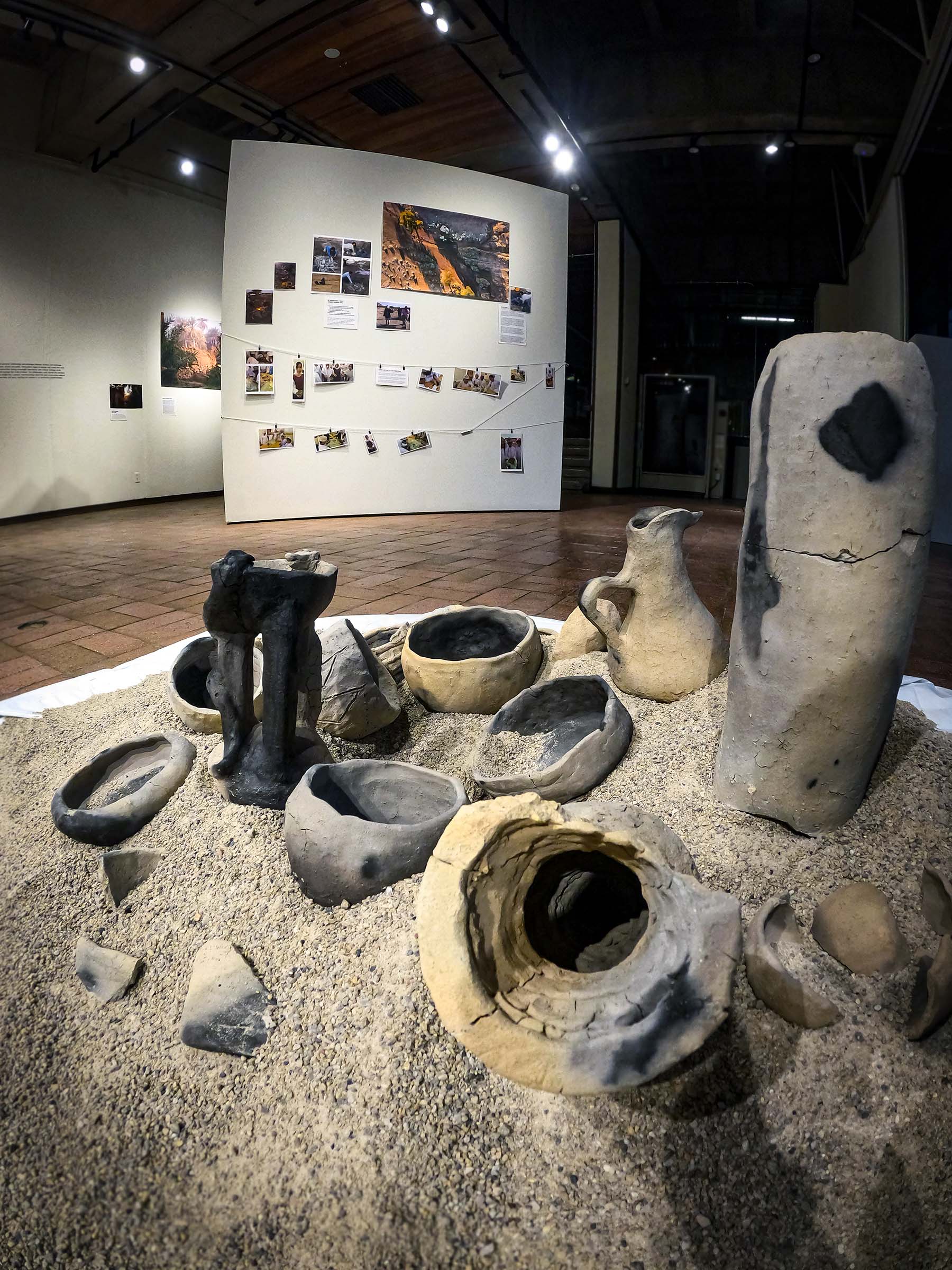 "Intuitive Survey” exhibition in the Gittins Gallery (Photo: Amelia Walchli)I came to the MFA in Community-based Art Education (CBAE) program as an archaeologist-turned-spy. My mission was to identify and obtain the collaborative skills of artists, to address systemic cultural heritage and contested narratives of the past. Utah's legacy includes unique historical, geographic, and social borderlands. It has always been home to travelers, migrants, and people who persisted at the edges and have woven their legacies together over time to create something new. In untangling these pasts in my work as an archaeologist, I was looking for ways to challenge, unite, and address them as an artist.
"Intuitive Survey” exhibition in the Gittins Gallery (Photo: Amelia Walchli)I came to the MFA in Community-based Art Education (CBAE) program as an archaeologist-turned-spy. My mission was to identify and obtain the collaborative skills of artists, to address systemic cultural heritage and contested narratives of the past. Utah's legacy includes unique historical, geographic, and social borderlands. It has always been home to travelers, migrants, and people who persisted at the edges and have woven their legacies together over time to create something new. In untangling these pasts in my work as an archaeologist, I was looking for ways to challenge, unite, and address them as an artist.
My favorite radical approach was to "learn by doing." In the CBAE program, I learned by doing. I learned that arts have the power not only to integrate disciplines but tell a story. Through the stories we convey as artists, we can include communities as creative collaborators, capable of changing our circumstances and realities. Together, we can tell and create our own stories while honoring the pathways and intentions of those who came before us.
Knowing everything is less important than getting out there and adapting with your boots on the ground. So I went out there, boots on, and I learned some great "secrets" of artists, like radical pedagogy, co-intentional educational approaches, and the power and weight of community relationships.
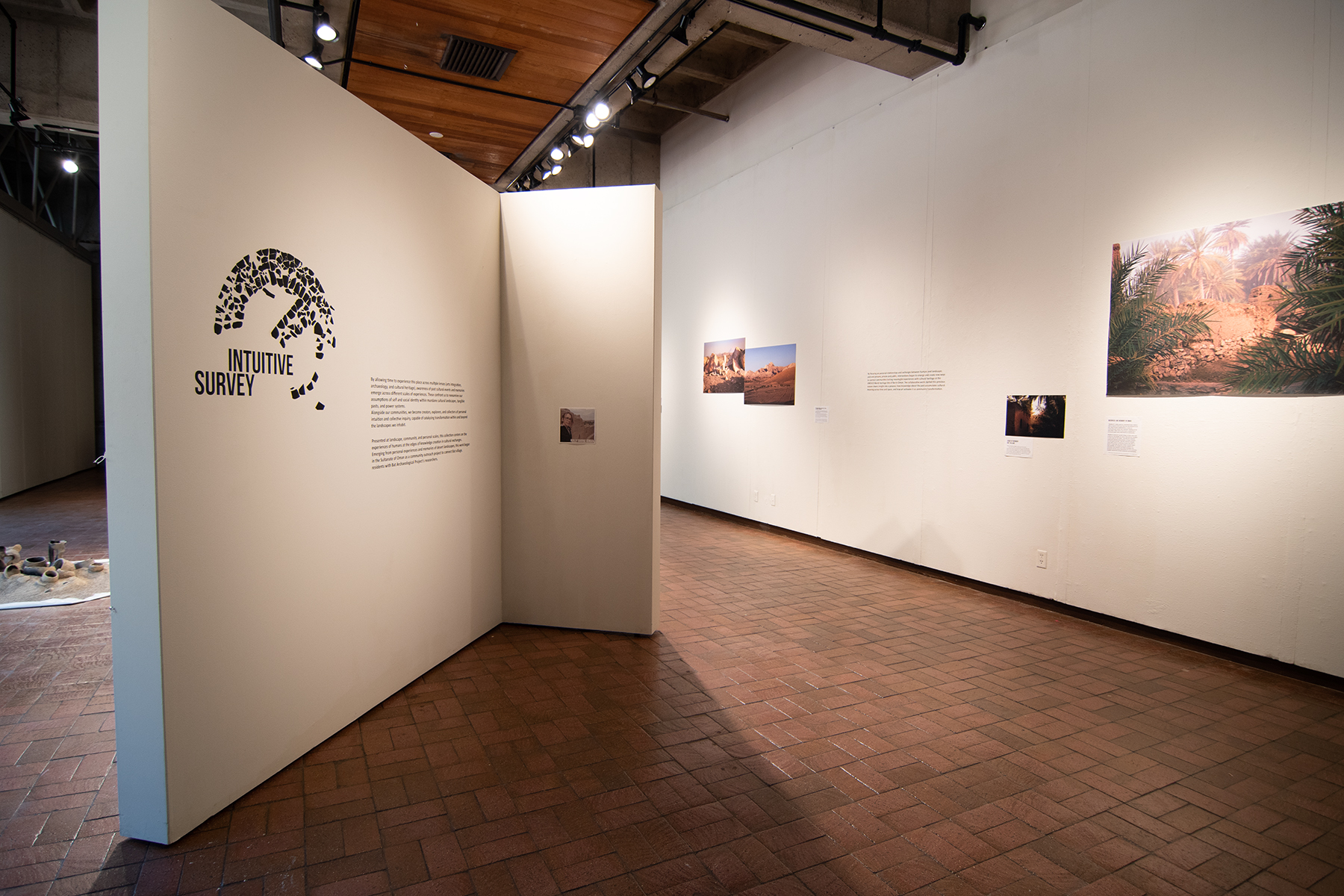 "Intuitive Survey” exhibition in the Gittins Gallery (Photo: Amelia Walchli)I put it all together into a community-based ceramics project for my MFA thesis with the Bat Archaeological Project, funded by the National Endowment for Humanities, at the UNESCO World Heritage Sites of Bat, Khutum, and Al Ayn, in the Sultanate of Oman. There, I worked with scientists, artists, and local schools to harvest local clay and create ceramics, as a means to research Bronze-Age ceramics processes and generate questions about the cultural past and our relationships to it through the creation of heritage.
"Intuitive Survey” exhibition in the Gittins Gallery (Photo: Amelia Walchli)I put it all together into a community-based ceramics project for my MFA thesis with the Bat Archaeological Project, funded by the National Endowment for Humanities, at the UNESCO World Heritage Sites of Bat, Khutum, and Al Ayn, in the Sultanate of Oman. There, I worked with scientists, artists, and local schools to harvest local clay and create ceramics, as a means to research Bronze-Age ceramics processes and generate questions about the cultural past and our relationships to it through the creation of heritage.
While the MFA thesis culminated in a local exhibition on campus, the work continues. You can find me gearing up for this coming field season, follow my process here or on Instagram: @quaffingreilly.
The U Department of Film & Media Arts has collaborated with UNP Hartland Partnership Center to offer an introductory film course as part of the Youth Voices program, serving young people in the south west side of Salt Lake county.
The following story is shared from UNP’s annual publication, Community Voices
HARTLAND SCHOLARS: Youth Voices and Intro to Film
By Ana Antunes, Assistant Professor, Gender Studies
Joshua Samson, Graduate Assistant, Education Leadership & Policy
Jeilani Athman, Student Success Advocate
Jarred Martinez, Education Pathways Partnership Manager, UNP
Youth Voices is a youth participatory research-based partnership hosted at the UNP Hartland Partnership Center. In its seventh year, Youth Voices was developed to increase educational opportunities for young people on the south west side of Salt Lake county. In order to fulfill this goal, Youth Voices engages youth through art, research, and prosocial activities. In partnership with faculty and staff from multiple departments at the University, the pursuit of this work has also inspired the emergence of what we’re calling Hartland Scholars. Hartland Scholars is an early-college credit program, centering the youth, values, and experiences of the community we work with, while challenging the expectations and barriers that exist in other early admissions programs.
As part of this growing pathway, students are taking Introduction to Film 1110 at Hartland, instructed by Joshua Samson. Students are learning technical and artistic aspects of filmmaking, representations of stereotypes, and basics of film production. Youth will also be making their own short films, as a form of counternarrative to Hollywood representations. Below are some reflections with Joshua Samson, expanding on the importance of this class and how it aligns with Youth Voices.
How does this course expand and deepen the Youth Voices way of thinking and learning?
JS: Students apply many of the concepts from Youth Voices into an analysis of film, which is one major marker of American culture. They unpack some of the hidden messages found in film and interrogate how dominant ideologies play out.
Why is understanding and examining media in this way so important?
JS: Media is pervasive in all young people’s lives and so learning to create their own media is one step towards media literacy. Instead of being passive consumers of media, they can begin to become active producers.
As a professor, what is an insightful or memorable experience you’ve had with this group?
JS: The students have been very engaged in applying the aspects of filmmaking. When we did a simple cinematography project, they were running around, imagining how they would film a scene. They are far more engaged than many of my other college students and I’ve been teaching for over a decade.
Upon successful completion and admission to the University of Utah, High school students will receive general education credit. However, just as importantly, they are also sharpening their abilities to read and write the world around them in creative ways.
Here are what some students had to say about what they’ve learned so far.
“[I] learn where movies come from, about different genres, about all the work that goes into making film and learned more about films that are not made in Hollywood.” — Fatima
“I learned about camera movements and different sounds and how it triggers different emotions. When you watch a movie you don’t usually think about the history of movies, but when you think about representation and people of color in films, it is important that we realize how far we still have to go.”
— Vicky
Community Engaged Learning program, UDance, shares movement with children with disabilities
Guest post by Stephanie Garcia and Joshua Yago Mora
Funded generously by the Sorenson Legacy Foundation, UDance is a new 16-week community and campus engaged learning program through the University of Utah's U-FIT recreational service-learning program for children with disabilities. College of Fine Arts Assistant Dean Kelby McIntyre-Martinez, and Wesley Wilson, PhD, from the Department of Special Education co-created UDance to bring families, university undergraduate students, and graduate students from both colleges together to create and implement adapted creative dance classes reciprocally.
"UDance is a community engaged learning program that challenges artists and educators to think inclusively regarding how we design and deliver art experiences in various educational and community spaces," said Assistant Dean McIntyre-Martinez.
Stephanie García and Joshua Yago Mora, MFA Modern Dance candidates and Sorenson Scholars from the School of Dance, have served as the creative dance instructors for UDance this past year.
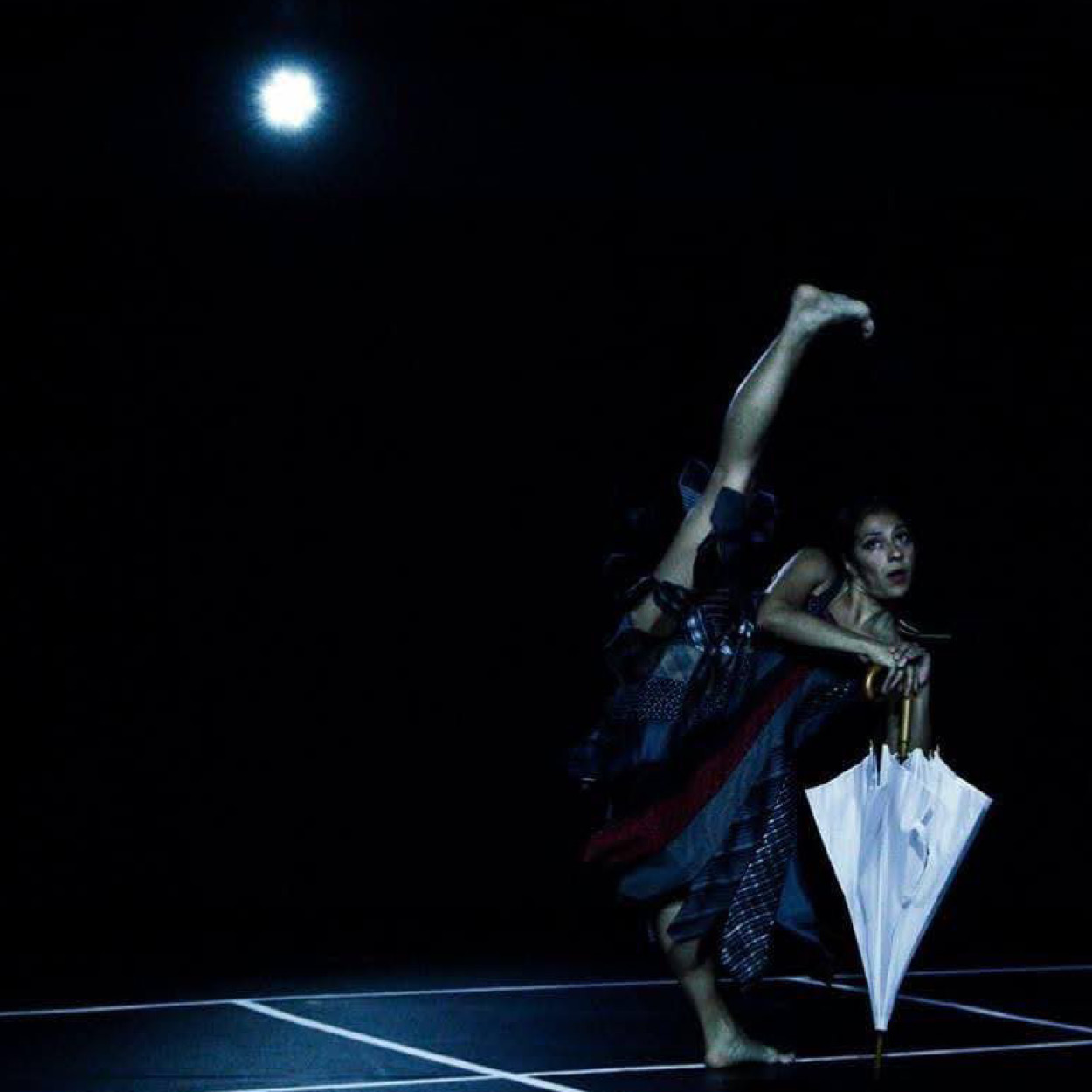 Stephanie Garcia dances on a dark stage, leg up, leaning on a white umbrella "We designed and implemented an adapted dance curriculum and assessed each session to effectively modify movement experiences to our participants' needs. This community-first process created an environment that encouraged a space where participants felt the freedom to express themselves authentically and supported sustained engagement each week," Garcia recalled. "Because we were working collaboratively alongside the community of participants, their movement preferences informed the design and implementation of our classes from week to week."
Stephanie Garcia dances on a dark stage, leg up, leaning on a white umbrella "We designed and implemented an adapted dance curriculum and assessed each session to effectively modify movement experiences to our participants' needs. This community-first process created an environment that encouraged a space where participants felt the freedom to express themselves authentically and supported sustained engagement each week," Garcia recalled. "Because we were working collaboratively alongside the community of participants, their movement preferences informed the design and implementation of our classes from week to week."
Throughout UDance, recorded outcomes for participants and feedback from parents included increased confidence as dancers through the enhanced application of fine and gross motor movement skills. For university student volunteers, many of whom are teachers-in-training, outcomes included professional development in teaching dance to those with disabilities.
Participants in UDance had opportunities to engage in various flexible thematic movements, music, and tactile activities.
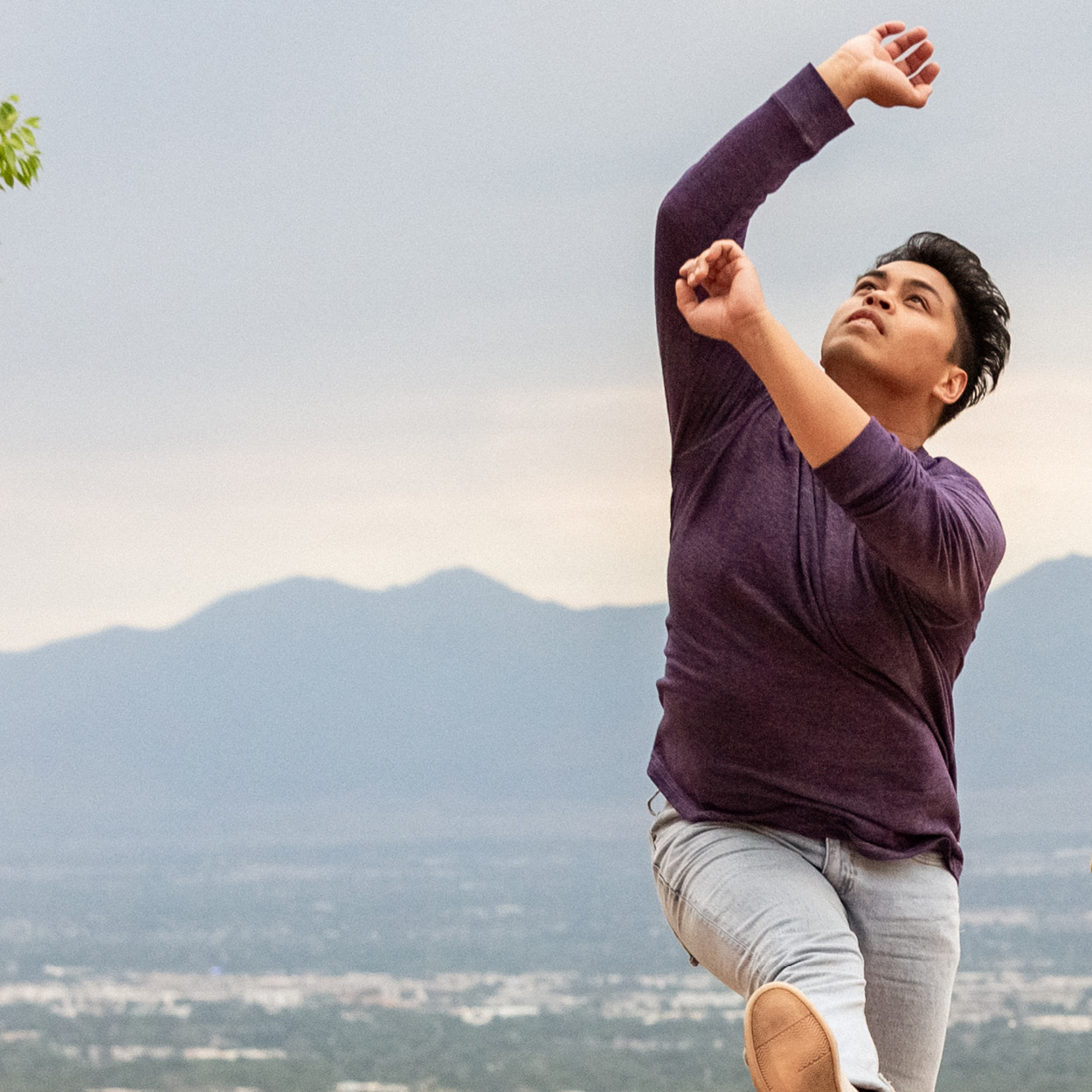 Joshua Yago Mora jumps in a dance, he's outside on a hillside overlooking the city (photo: Todd Collins"It was truly wonderful to see a change occur as the students became more comfortable with themselves and their bodies,” Mora reflected. “As soon as they walked into the dance space, I noticed their weight change and spine lengthening. Even in standing, seeing how one student would arrive into his ‘dancing body’ created such delight; it was hard not to get caught up in this shift in the space.”
Joshua Yago Mora jumps in a dance, he's outside on a hillside overlooking the city (photo: Todd Collins"It was truly wonderful to see a change occur as the students became more comfortable with themselves and their bodies,” Mora reflected. “As soon as they walked into the dance space, I noticed their weight change and spine lengthening. Even in standing, seeing how one student would arrive into his ‘dancing body’ created such delight; it was hard not to get caught up in this shift in the space.”
Garcia spoke about the the enjoyment of movement she witnessed during weekly dance classes and how incredible it was.
“Spending time with communities who possess different needs, who are typically marginalized, ignored, and erased, is a way to create awareness of these individuals' experiences and how I can be an active agent for transformation. As a dancer, UDance taught me to create movement experiences where participants are empowered as independent choice-makers through creative tasks. I was reminded each week of the value of providing all movers and creators an environment of equity.”

